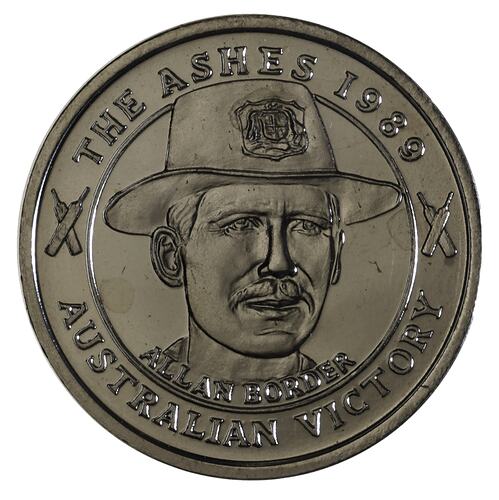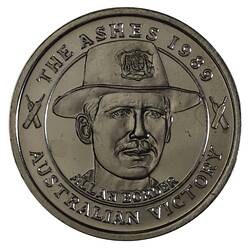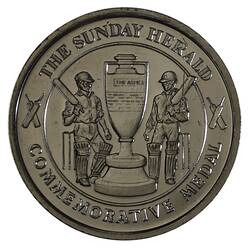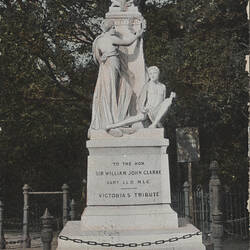Summary
Uncirculated nickel medal issued in 1989 by the Sydney newspaper the Sunday Herald to commemorate the Australian victory in the 1988 Ashes cricket series.
It features a portrait of Alan Border and, on the reverse, the Ashes Urn. The newspaper advertised a give-away of the medals on 8 October 1989. The Ashes tradition originated in England in August 1882, when an Australian cricket team defeated England, in England, for the first time. This prompted English journalist Reginald Brooks to write a mock obituary in The Sporting Times, saying that English cricket had died, and that the body would be cremated and the Ashes taken to Australia. The joke continued, and it is suggested that Lady Clarke, wife of Sir William Clarke, President of the Melbourne Cricket Club, burnt her veil and presented the ashes (purporting to be a bail) to English Captain Ivor Bligh, who was playing with his team at the Clarke property in Sunbury, Rupertswood, on Christmas Eve 1882.
Obverse Description
Within a line circle three quarter facing head, below, 'ALAN BORDER' above, 'THE ASHES 1989'; below, 'AUSTRALIAN VICTORY'. Crossed bats at '03 & 09'.
Reverse Description
At centre within line circle, the Ashes Urn with batsmen left and right. Above, 'THE SUNDAY HERALD'; below 'COMMEMORATIVE MEDAL'; crossed bats at '06 & 09'.
Edge Description
Plain.
Significance
In August 1882 an Australian cricket team defeated England, in England, for the first time. This prompted English journalist Reginald Brooks to write a mock obituary in The Sporting Times, saying that English cricket had died, and that the body would be cremated and the Ashes taken to Australia. The wording of this 'obituary' related to a contemporary debate about human cremation. Brooks' father belonged to a society aiming to have human cremation legalized. Thus the obituary notice both mourned the loss of English supremacy and made reference to the cremation debate. When English Captain Ivor Bligh went to Australia at the end of that year he kept the joke alive by saying he was going to bring the Ashes home.
The actual ashes perhaps originated at Rupertswood, the Sunbury property of Sir William Clarke, President of the Melbourne Cricket Club. On Christmas eve 1882 Clarke had family guests staying for Christmas and invited the English cricket team to play a game there. At the end of the game Janet, Lady Clarke, decided to present Captain Ivor Bligh with the object he said he had come out to retrieve. She burned her veil, put the ashes into a small urn and presented it to Bligh (some suggest that the ashes purported to be those of a burnt bail).
A less credible claim suggests that the Ashes came into being after the Third Test in Sydney in 1883. The claim is based on the fact that a velvet bag which accompanies the urn is dated 1883, the year England won the Third Test and therefore the series. However the bag, made by Annie Fletcher (wife of the Paddington Club Secretary), may have merely been intended to mark the date of the actual winning of the ashes by England.
Interview on ABC 'Sports Factor' of Joy Munns, author of Beyond Reasonable Doubt, by Amanda Smith.
More Information
-
Collecting Areas
-
Acquisition Information
Donation from Mr Euan McGillivray, 08 Oct 1989
-
Date Issued
1989 AD
-
Issued By
-
Person Depicted
-
Inscriptions
Obverse; 'ALAN BORDER' above, 'THE ASHES 1989'; below, 'AUSTRALIAN VICTORY'. Crossed bats at '03 & 09'. Reverse; 'THE SUNDAY HERALD' below, 'COMMEMORATIVE MEDAL'; crossed bats at '06 & 09'.
-
Series
-
Material
Nickel
-
Axis
12
-
Classification
-
Category
-
Discipline
-
Type of item
-
Overall Dimensions
26 mm (Outside Diameter), 8.308 g (Weight)
-
Dimensions
26 mm (Outside Diameter)
-
Shape
Round
-
References
References: [Link 1] -D. Tout-Smith 9/2003.
-
Keywords




